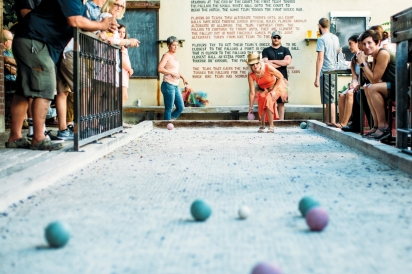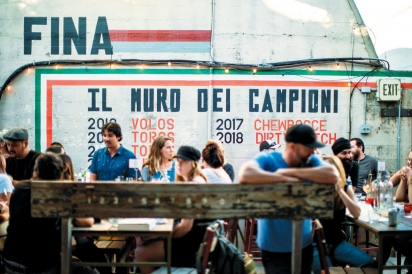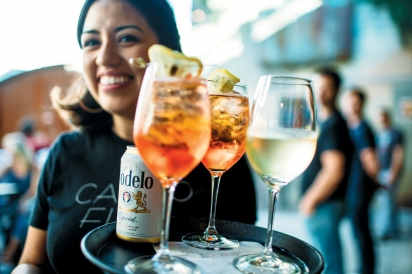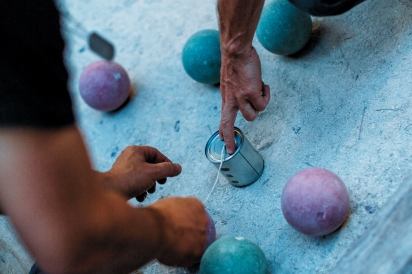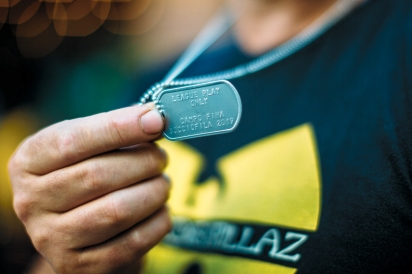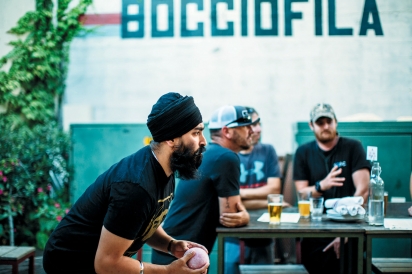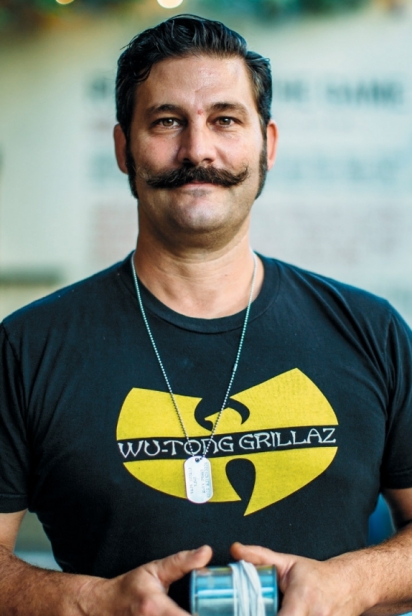All's Fair in Love and Bocce
BURRATA, BOOZE AND BALLS TAKE CENTER COURT IN THE NORTH BAY
What sport can be played in the middle of an urban area, in a relatively small space, by people of all ages, requires little to no athletic ability and seems to be greatly enhanced by having a glass of wine in hand? If you’re thinking “bocce,” you’re correct.
If this sounds like your ideal warm weather “outing,” you’re not alone.
Near the corner of North Street and Healdsburg Avenue in Healdsburg sits the Italian restaurant Campo Fina. Inside, it’s a farm-to-table dining scene common to the area: exposed brick, wood flooring and other reclaimed materials. Lounge seating in a deep oxblood hue reminiscent of old-time Brooklyn invites lengthy, drawn-out conversations over Zinfandel. And then you note that the long bar is framed by a curious image: a man in silhouette throwing a small ball. A teaser that something about this place is unique.
Venturing beyond the restaurant’s narrow interior and the filament-bulb- lit patio, you’ll find a rectangular pit filled with crushed gravel and, in season, a crowd of people gathered in and around it—the bocce court. The “Rules of the Game” are painted onto one of the surrounding patio walls, a sign of how deeply embedded the sport of bocce is to Campo Fina, and to the neighborhood itself.
Campo Fina’s chef and owner Ari Rosen specifically chose the restaurant’s location for its outdoor patio space and gameplay potential, he says. “I had this image of opening up a place where you could drink, eat and play bocce—like we did in my family growing up.”
Rosen, who was also the chef and owner at the now-closed Healdsburg restaurant Scopa, has spent his life surrounded by both family and food. With Campo Fina—“campo” refers to both agricultural fields and sporting fields—he says he wanted to pay tribute to childhood memories of tossing around his grandfather’s set of bocce at family gatherings. He wanted to celebrate the pleasure that comes from eating, drinking and playing games. The enjoyment of life as, some say, Italians do best.
Campo Fina is but one example of a growing trend across the North Bay of evolving an ancient game brought to our area by Italian immigrants and carried forward largely by their offspring into a trendy sport for a new, younger crowd, played out on neighborhood courts, as well in more glamorous locations like wineries and restaurants.
In Petaluma, 30-somethings stop by Brewster’s Beer Garden for a drink and a friendly pickup bocce game. Residents of Santa Rosa roll their balls at Juilliard Park, where both the Sonoma County Bocce Club and Santa Rosa Bocce League hold their competitions.
The bocce league in Napa County’s St. Helena has operated for close to 40 years, and some of the current 1,600 members boast fathers who were founders of the program. Today, the league is so popular that there is typically a waiting list on five of the six nights, and it challenging for new teams to break in. Stephanie Iacobacci, recreation supervisor for the City of St. Helena, reports that the spring and summer league based in Crane Park is the largest adult recreation program in the Napa County area. In fact, it was disputes over court space that led the city to eventually step in and take over the management of the league.
By our count, 12 wineries in Napa and 25 in Sonoma have bocce courts, marrying the tradition of wine tasting with a little competitive fun (made all the more enjoyable fortified with a little liquid courage).
Northern California Wine Country’s love affair with bocce began in the early 1900s, when Italians immigrated to the area, bringing with them, among many other things, a love of wine and lawn sports like bocce and the similar French game known as “boules,” and petanque, the latter played with smaller metal balls and a lobbing or tossing motion different from bocce’s “bowling” technique. So what explains the recent resurgence?
Bocce buffs at Campo Fina say it’s because the game is social, fun and all-inclusive.
“Anyone can play,” says Ari Rosen. “My grandfather is 98 and he only stopped playing last year. I used to challenge anyone under 97 to play him with a $5,000 prize.”
“I never found anyone,” he laughs.
And, of course, there’s the element of drinking: the game and libations literally go hand-in-hand.
“Some people won’t throw without a glass of wine in hand,” says Iacobacci. “I hear people say, ‘It balances me out.’”
Another draw of bocce is the sheer simplicity in gameplay. From the Italian word boccia, which means “to bowl,” the game revolves around two teams bowling against one another to get as close as possible to a target. The match begins with a member of one team throwing a small ball, called the pallino or jack, from one end of the court. Then, the teams switch off throwing the larger balls (eight in total, four for each team), called the bocci, at the pallino. The team closest to the pallino after all team members have thrown wins the point. The balls are traditionally made of wood or metal, but nowadays are often made of a durable plastic.
The court material plays a vital role in gameplay—no two courts are the same, which means players might play stronger on one court than on another. Campo Fina has a crushed gravel surface; some use crushed oyster shells or just plain old dirt. St. Helena’s Crane Park site includes eight meticulously maintained 60-foot bocce courts filled with a decomposed granite core. A court groomer polishes the courts three or four days a week during the season, and more often during the playoffs and championship games at the end of the season.
The park also allows alcohol—not always the case in public outdoor spaces. This is Wine Country, after all. With alcohol involved, sometimes disagreements can become heated, but, according to Iacobacci, there’s more drama about managing the food that always accompanies gameplay.
“Many teams have a ‘theme’ night, like cheese dishes only. Because everyone loves food so much, everyone goes over the top with these elaborate home-cooked dishes. And then there’s this one player who always brings a bag of Oreos.”
Campo Fina is the competition grounds for the Sonoma County Bocce League, consisting of 32 teams of four, and a whole lot of personality. Two nights a week (Wednesdays and Thursdays) during the five-week season, Campo Fina reserves its court to league members only, when teams with names like “Mission Imbocceball,” “Boccelism” and “Bend it like Bocce” battle it out for bragging rights, as well as real prizes. The court is open to anyone the other nights of the week.
This year 38 teams showed up to play at Campo Fina, forcing Rosen to turn some away. It’s a testament to how synonymous the restaurant and bocce have become—a reputation spread mostly by word-of-mouth over the last seven years.
While a bocce lover himself, Rosen does not play on game nights. He prefers to act as referee, measuring the distance between each bocce and the pallino with a line of string attached to a soup can, a low tech tool he calls “the Cannibal.”
“The house doesn’t play,” he says. “It keeps things fair.”
In St. Helena, as well as in other bocce leagues in the area, team captains typically come together to form a ruling on any controversial call. This leads to some grey areas with sticking to the rules of the United States Bocce Federation (USBF)—so long as the team captains come to terms, the ruling flies. Rosen likes to provide an objective review to keep play lighthearted and fun. As anyone who watches the nightly games at Campo Fina can attest, the competition can get serious.
“It’s a blast. People get really into it. Just like any other sport, there’s razzing and things I might not notice if I wasn’t a ref—some teams send a round of drinks to another team in the hopes of getting them drunk. Someone once seated an ex-girlfriend nearby as a distraction. It’s all fun and games.”
As for any serious competition?
“One year people almost got into a fistfight. I’m there to stop the bad vibes and bad calls.”
“Everyone remembers the bad calls,” Rosen jokes.
Bocce is so popular in St. Helena that many tour operators now keep a bocce set on hand to entertain their “game” clients—offering them the opportunity to really live like locals.
What’s particularly compelling about these local bocce leagues is the opportunity for residents of all walks of life to engage with one another. Bocce evens the playing field—it doesn’t matter what your station in life, what you do or how much you earn.
Iacobacci reflects, “No one really highlights this, but it’s so cool to see how bocce brings everyone together.”
At Campo Fina, Crane Creek and other North Bay bocce destinations, the sentiment is the same—everyone is looking to have a good time, and what better way than to serve up some antipasti, wine or a cocktail or two, and…
“BOCCE!”.
For more information on bocce at Campo Fina, visit CampoFina.com/bocce.html; and in St. Helena, visit CityOfStHelena.org/parksrec/page/st-helena-bocce.



